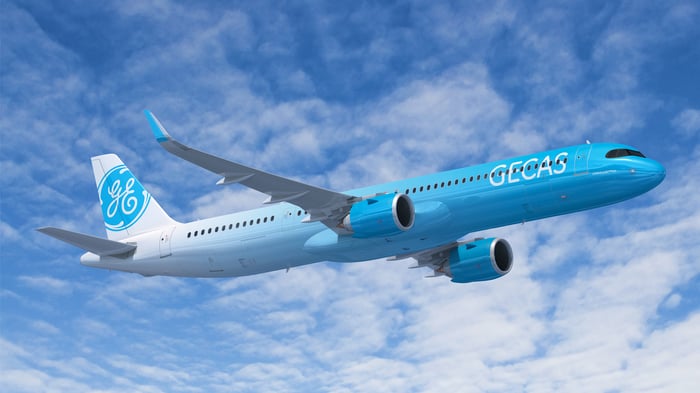The coronavirus pandemic has created major risks for aircraft leasing companies. Air travel demand evaporated earlier this year, putting many airlines at risk of defaulting on their aircraft leases. Depending on how long the travel downturn lasts, the resulting losses could strain the leasing companies' balance sheets.
Yet at the same time, many airlines will be in no position to buy new aircraft in the years ahead. That will make leasing more attractive as they look to replace older aircraft and (eventually) return to growth.
General Electric (GE -0.69%), owner of GECAS, one of the two largest aircraft leasing companies in the world, has a plan to address that expected need. Earlier this week, GECAS announced a new partnership with investment manager PIMCO to create a $3 billion aircraft leasing platform.

Image source: GECAS.
An industry facing short-term challenges
So far, the pandemic hasn't led to big losses for aircraft lessors. The companies typically hold significant deposits from customers, cushioning them from losses if airlines stop paying -- provided that they can quickly repossess and re-lease the aircraft in question at similar rates.
But the longer the air travel downturn drags on, the bigger the risk of losses. Some major airlines outside the U.S. have filed for bankruptcy, allowing them to terminate or renegotiate aircraft leases. Many more have requested payment deferrals, exposing lessors to additional credit risk in the event that some of those carriers go bankrupt.
Meanwhile, a shortage of commercial aircraft has quickly turned into a glut. Few if any airlines are looking to lease (or buy) used jets that come on the market due to bankruptcies or natural lease expirations. This could lead to meaningful losses depending on how many jets are returned or repossessed in the next year or two. That could potentially make it harder for aircraft leasing companies to make the investments in new aircraft that they will need to meet demand a few years down the road.
A new platform for growth
On Monday, GE's GECAS unit announced a preliminary agreement with PIMCO to create a $3 billion aircraft leasing platform. The partnership will focus on young or brand-new narrow-body jets to start, although it may diversify into wide-body aircraft over time. The focus on narrow-bodies makes sense. This is the most liquid part of the market (reducing risk), and nearly all experts believe that demand for short-haul flights will recover much faster than the long-haul market.
"GECAS will source transactions for the platform, act as servicer and provide asset management services for the platform," according to the press release. Meanwhile, PIMCO will provide capital, removing some of the burden on General Electric, which has competing needs such as debt reduction, pension funding, and building up insurance reserves.
For GECAS, servicing assets that are partly or wholly owned by other institutions is nothing new. As of the end of 2018, it had $6 billion of serviced assets from partners, up from $3 billion two years earlier. The PIMCO deal would significantly expand this third-party business over time.
A smart way to pivot
In recent years, GECAS has been a reliable profit generator for General Electric. While profitability can be somewhat lumpy based on the timing of gains, GECAS has earned an adjusted profit between $1 billion and $1.4 billion every year since 2014.
But it reported a roughly $300 million impairment charge in the second quarter based on a review of leases it viewed as higher-risk. The company undertook its more-thorough annual portfolio review last quarter, which could lead to additional impairments. (Investors will find out when GE reports its earnings next week.) This highlights the risk inherent in any financing business.
By contrast, by growing its base of serviced assets, GECAS is capitalizing on its asset management expertise to develop a low-risk profit stream. Considering all of the risks and near-term headwinds that GE's core business faces, that's exactly what General Electric needs right now.





